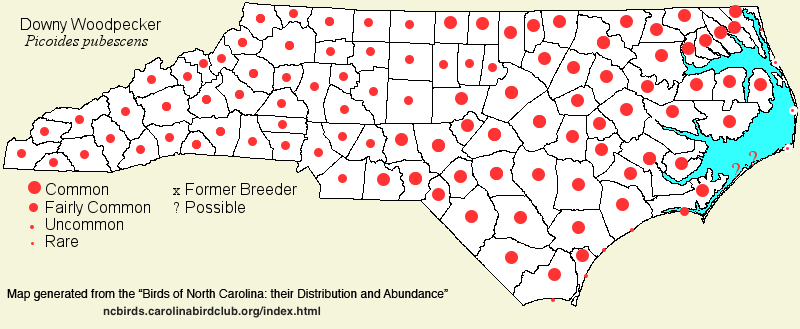 |  |
|
Downy Woodpecker - Dryobates pubescens PICIDAE Members: | Search Common: Search Scientific: |
|
|
|||||||
| General Comments | This is our smallest woodpecker, and because of its size and rather quiet and retiring ways, the Downy Woodpecker can be easily overlooked, though it is generally a common and familiar bird. It occurs across the state at all seasons and is mostly nonmigratory, though birds do appear in out-of-the-way places in fall migration. It has a wide array of forested habitats, and because of its size, it often occurs in middle-aged forested stands, as well as in mature forests. Breeding and wintering habitats include upland and bottomland forests, swamps, wooded residential areas, and parks and groves. Hardwoods are favored over conifers, though it does occur in pine stands. In winter, mixed species flocks of chickadees, titmice, kinglets, and other songbirds typically contain one or two Downy Woodpeckers; and the species often visits feeders in winter to take suet. | ||||||
| Breeding Status | Breeder | ||||||
| NC BRC List | Definitive | ||||||
| State Status | |||||||
| U.S. Status | |||||||
| State Rank | S5 | ||||||
| Global Rank | G5 | ||||||
| Coastal Plain | Permanent resident; essentially nonmigratory. Generally common (though easily overlooked) over most of the province; along the coast (barrier islands), it is much less numerous and is mostly uncommon in suitable wooded habitats, and it can be scarce in the breeding season. Peak counts: ? | ||||||
| Piedmont | Permanent resident; essentially nonmigratory. Generally common but easily overlooked, essentially throughout the province, but only fairly common in the foothills. Peak counts: ? | ||||||
| Mountains | Permanent resident, with few migratory movements. Generally fairly common all year, below 4,000 feet; uncommon above 4,000 feet, and typically absent at high elevations (over 5,000 feet). Peak counts: | ||||||
| Finding Tips |
None needed. A few are usually seen or heard in a day of birding anywhere in the state. *** to **** | ||||||
| Attribution | LeGrand[2023-03-22], LeGrand[2012-07-14], LeGrand[2011-12-10] | ||||||
| NC Map Map depicts all counties with a report (transient or resident) for the species. | Click on county for list of all known species. |
| NC Breeding Season Map Map depicts assumed breeding season abundance for the species. |  |